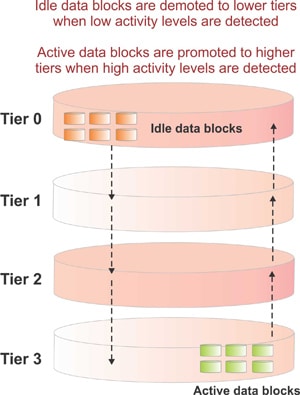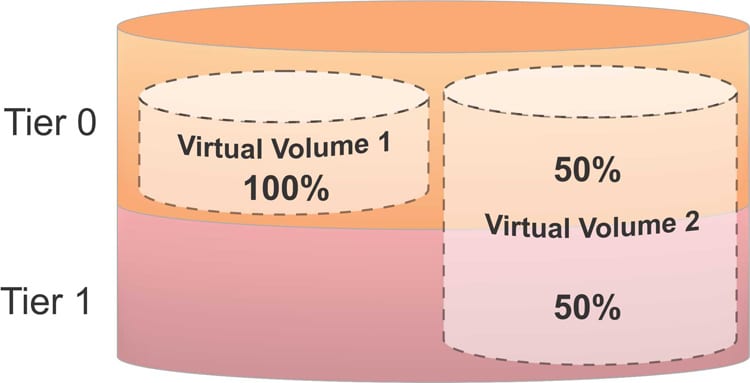By: Galvin Chang, Associate Director of Global Marketing, Infortrend Technology, Inc.
In enterprise datacenters, the focus of IT managers is evolving from pursuing the latest technologies and resources to ensuring that existing available resources are used most efficiently. By optimizing efficiency, enterprises can better protect their investments and ensure they achieve a high ROI.
In data storage, this development trend is similarly evident, highlighted by up-and-coming features, such as data deduplication and thin provisioning, that optimize storage utilization and have become widely popular in the market.
Another example is automated storage tiering, a technology gradually moving to the mainstream of the enterprise storage market. Automated storage tiering can help enterprises meet a wide array of service level requirements in the datacenter with an automated architecture that increases ROI and simplifies management.
What is automated storage tiering?
Storage tiering involves grouping data into different categories and assigning these categories to different types of storage media in order to optimize storage utilization. Data categories can be distinguished based on performance levels, usage frequency, cost/performance considerations and others.
 A rudimentary example of storage tiering is the use of tape storage media, whereby companies archive older data on tape while assigning their disk-based media to store current, high-performance applications. However, earlier rudimentary forms of storage tiering almost completely rely on manually initiated processes. These manual processes involve classifying data and determining the importance of data to an organization, as well as configuring different storage media so that data can be migrated between media and different storage tiers can be achieved.
A rudimentary example of storage tiering is the use of tape storage media, whereby companies archive older data on tape while assigning their disk-based media to store current, high-performance applications. However, earlier rudimentary forms of storage tiering almost completely rely on manually initiated processes. These manual processes involve classifying data and determining the importance of data to an organization, as well as configuring different storage media so that data can be migrated between media and different storage tiers can be achieved.
More recently, automated mechanisms have become a larger part of storage tiering architectures. Embedded algorithms in storage solutions help to classify data and determine what type of priority should be assigned to each set of data. In addition, once data has been properly classified, automated data migration processes help to move data between different types of storage media so that a tiered architecture can be fully optimized.
Two main purposes of storage tiering can be distinguished: ensuring that each application has access to its required performance levels, and migrating data that has already been stored to higher or lower tiers based on data usage patterns, in order to achieve the most efficient distribution of data within a storage system.
Different types of architectures are used to implement storage tiering. Major differences between architectures revolve around factors such as whether tiering is implemented in a file-based or block-based structure, and whether tiering is either host-based or storage-based. Another important distinction is between software- or hardware-based implementations.
How does automated storage tiering benefit enterprise datacenters?
Enterprise datacenters serve a wide range of applications that can differ greatly in terms of service level requirements. The ability to easily meet different service levels without complex system configurations is therefore very important to enterprises.
Automated storage tiering helps enterprises ensure that their applications have access to the service levels they need. High-performance applications can be assigned to high-performance tiers featuring SSDs or SAS drives, while applications requiring less performance can be assigned to lower tiers featuring nearline drives.
In addition, automated data migration processes help users store data on the proper media without large-scale, manually driven configurations. Based on embedded algorithms, data storage solutions automatically migrate data between different tiers, storing new, active data on higher tiers and older data on lower tiers.
Many solutions in the enterprise segment now offer sub-volume (or sub-LUN) tiering, ensuring that a single data volume (LUN) can be stored across multiple tiers. Sub-volume tiering can greatly increase the efficiency of automated data migration by moving data across tiers in much smaller units.
Automated storage tiering also enables storage performance to be greatly optimized by efficiently integrating SSDs, which deliver performance levels far beyond what SAS or nearline drives are able to offer. In the past, enterprises were forced to assign whole data volumes to SSDs, thereby also storing older data in these volumes on SSDs and taking away valuable resources that could be better used for newer data serving mission-critical applications.

With sub-volume tiering, older data within a data volume can be automatically moved to lower tiers and thereby not occupy valuable space on SSDs. Adopting SSDs in a sub-volume tiering architecture thus enables users to meet the stringent demands of mission-critical applications in a cost-effective way.
For example, if an enterprise used to rely fully on SAS drives to serve mission-critical applications in a non-tiering storage solution, they can significantly increase their performance levels by integrating SSDs in a storage tiering solution without adding any costs.
The increased efficiency that can be achieved with storage tiering helps increase the lifespan of storage solutions and reduce storage footprint and power consumption. Power consumption is also reduced by the use of SSDs in storage tiering architectures, as these drives consume only limited amounts of power when compared to other drive types.
Furthermore, automated storage tiering solutions help enterprises greatly simplify storage management. For traditional storage solutions without tiering technology, IT administrators have to manually configure data migration operations and assign applications to specific storage media. With automated storage tiering, many of these operations are done automatically, simplifying management, reducing time administrators have to spend on storage management, and thereby lowering management costs.
Degree of user input can maximize benefits
Even with all the aforementioned automated mechanisms, a degree of user input can be very useful to help enterprises maximize the benefits of automated storage tiering. User input can be important in several aspects, including the timing of data migration and the way in which volumes are stored across multiple tiers with sub-volume tiering.
The advantages of automated data migration have been described above, yet perhaps one of the most important aspects of data migration is when it occurs. Many solutions conduct data migration according to schedules set by the system itself. However, data migration requires computing resources, and conducting data migration during business hours when applications are running at full speed may not be the best available option due to the potential performance impact.
Scheduling options with which users can decide themselves when data migration is conducted are therefore very important. In this way, users can ensure data migration occurs during off-peak hours so that any impact on applications can be avoided.
Another area in which user settings can be important is the way in which a data volume is divided over different tiers in sub-volume tiering solutions. If a user has the ability to specify the ratios in which a volume is stored on different tiers, sub-volume tiering can be fine-tuned based on specific application characteristics. For example, if a user finds that a large part of a data volume serves mission-critical operations, being able to allocate a corresponding ratio of the data volume to higher tiers can optimize resource utilization.
Fully dedicated to storage solutions, Infortrend has a strong technological foundation that includes one of the best R&D teams in the industry. Our expertise covers all aspects of storage systems, including hardware, firmware, software and system integration. To ensure product excellence, Infortrend systems are designed and manufactured in-house.




 Amazon
Amazon